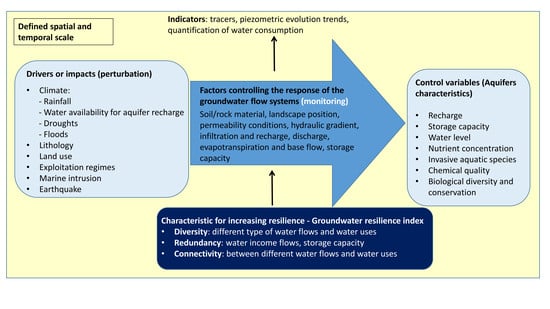The Ecosystem Resilience Concept Applied to Hydrogeological Systems: A General Approach
Abstract
1. Introduction
2. Hydrogeological Systems and the Resilience Concept
2.1. Hydrogeological Systems as Complex Systems
2.2. The Resilience Concept and Theory
2.3. Resilience from Ecology to Hydrogeology: A Conceptual Framework for Its Analysis
3. Conceptual Model Applied to a Real Case: The Upper Guadiana Basin in Central-West Spain
3.1. First Step: Description of the System, Flows and Functions
3.2. Water Quality in Tablas de Daimiel National Park: Baseline Stage (September–October 1974)
3.3. Second Step: Description of the Perturbation
3.4. Third Step: Description of the New State of Equilibrium
3.5. Water Quality in Tablas de Daimiel National Park: Pumping Stage
3.6. Water Quality in Tablas de Daimiel National Park: Restoring Stage
3.7. Surface Flaming Fires and Smoldering Peat Fires
4. Discussion—The Need for Good Quality Long-Term Data
5. Conclusions
Author Contributions
Funding
Acknowledgments
Conflicts of Interest
References
- Hinsby, K.; Troldborg, L.; Purtschert, R.; Corcho Alvarado, J. Integrated dynamic modelling of tracer transport and long term groundwater/surface water interaction using four 30 year 3 h time series and multiple tracers for groundwater dating. In Isotopic Assessment of Long Term Groundwater Exploitation; Edition: IAEA-TECDOC-1507; International Atomic Energy Agency, IAEA: Vienna, Austria, 2006; pp. 73–95. [Google Scholar]
- Llamas, M.R.; Custodio, E. Intensive Use of Groundwater. Challenges and Opportunities; Llamas, M.R., Custodio, E., Eds.; Fundación Marcelino Botín. A.A. Balkema: Amsterdam, The Netherlands, 2003; pp. 1–478. [Google Scholar]
- Sophocleous, M. Environmental implications of intensive groundwater use with special regard to streams and wetlands. In Intensive Use of Groundwater. Challenges and Opportunities; Llamas, R., Custodio, E., Eds.; IGME, Generalitat Valenciana, Fundación Marcelino Botín. A.A. Balkema Publishers: Lisse, The Netherlands; Abingdon, UK; Exton, PA, USA; Tokyo, Japan, 2003; pp. 93–112. [Google Scholar]
- Llamas, M.R.; Varela-Ortega, C.; De La Hera, A.; Aldaya, M.; Villarroya, F.; Martínez-Santos, P.; Blanco-Gutiérrez, I.; Carmona-García, G.; Esteve-Bengoechea, P.; De Stefano, L.; et al. The Guadiana Basin. In The Adaptive Water Resource Management Handbook; Mysiak, J., Henrikson, H.J., Sullivan, C., Bromley, J., Pahl-Wostl, C., Eds.; Earthscan: London, UK, 2010; pp. 103–114. [Google Scholar]
- Zorrilla, P.; Carmona, G.; De la Hera, A.; Varela-Ortega, C.; Martínez-Santos, P.; Bromley, J.; Henriksen, H.J. Evaluation of Bayesian Networks in Participatory Water Resources Management, Upper Guadiana Basin, Spain. Ecol. Soc. 2010, 15, 12. Available online: http://www.ecologyandsociety.org/vol15/iss3/art12/ (accessed on 10 March 2020). [CrossRef]
- Martínez Cortina, L. Marco hidrológico de la cuenca alta del Guadiana. In Conflictos Entre el Desarrollo de las Aguas Subterráneas y la Conservación de los Humedales: La Cuenca alta del Guadiana; Coleto, M.C., Martínez Cortina, L., Llamas, M.R., Eds.; Fundación Marcelino Botín y Ediciones Mundi-Prensa: Madrid, Spain, 2003; pp. 3–68. [Google Scholar]
- Castaño, S.; de la Losa, A.; Martínez-Santos, P.; Mediavilla, R.; Santisteban, J.I. Long-term effects of aquifer overdraft and recovery on groundwater quality in a Ramsar wetlands: Las Tablas de Daimiel National Park, Spain. Hydrol. Process. 2018, 32, 2863–2873. [Google Scholar] [CrossRef]
- Martínez-Santos, P.; Castaño-Castaño, S.; Hernández-Espriú, A. Revisiting groundwater overdraft based on the experience of the Mancha Occidental Aquifer, Spain. Hydrogeol. J. 2018, 26, 1083–1097. [Google Scholar] [CrossRef]
- Ahmed, K.; Shahid, S.; Demirel, M.C.; Nawaz, N.; Khan, N. The changing characteristics of groundwater sustainability in Pakistan from 2002 to 2016. Hydrogeol. J. 2019, 27, 2485–2496. [Google Scholar] [CrossRef]
- Golodkovskaya, G.A.; Eliseyev, J.B. Geological Media of Industrial Regions; Moscow “Nedra” Publishing: Moscow, Russia, 1989; pp. 1–220. [Google Scholar]
- Cuthbert, M.O.; Taylor, R.G.; Favreau, G.; Todd, M.C.; Shamsudduha, M.; Villholth, K.G.; MacDonald, A.M.; Scanlon, B.R.; Kotchoni, D.O.V.; Vouillamoz, J.M.; et al. Observed controls on resilience of groundwater to climate variability in sub-Saharan Africa. Nature 2019, 572, 230–234. [Google Scholar] [CrossRef] [PubMed]
- Maurice, L.; Taylor, R.G.; Tindimugaya, C.; MacDonald, A.M.; Johnson, P.; Kaponda, A.; Owor, M.; Sanga, H.; Bonsor, H.C.; Darling, W.G.; et al. Characteristics of high-intensity groundwater abstractions from weathered crystalline bedrock aquifers in East Africa. Hydrogeol. J. 2019, 27, 459–474. [Google Scholar] [CrossRef]
- Lorenzo-Lacruz, J.; García, J.; Morán-Tejeda, E. Groundwater level responses to precipitation variability in Mediterranean insular aquifers. J. Hydrol. 2017, 552, 516–531. [Google Scholar] [CrossRef]
- Mazi, K.; Koussis, A.D.; Destouni, G. Intensively exploited Mediterranean aquifers: Resilience to seawater intrusion and proximity to critical thresholds. Hydrol. Earth Syst. Sci. 2014, 18, 1663–1677. [Google Scholar] [CrossRef]
- Galassi, D.M.P.; Lombardo, P.; Fiasca, B.; Di Cioccio, A.; Di Lorenzo, T.; Petitta, M.; Di Carlo, P. Earthquakes trigger the loss of groundwater biodiversity. Sci. Rep. 2014, 4, 6273. [Google Scholar] [CrossRef]
- Chinnasamy, P.; Maheshwari, B.; Prathapar, S.A. Adaptation of Standardised Precipitation Index for understanding watertable fluctuations and groundwater resilience in hard-rock areas of India. Environ. Earth Sci. 2018, 77, 562. [Google Scholar] [CrossRef]
- De Eyto, E.; Jennings, E.; Ryder, E.; Sparber, K.; Dillane, M.; Dalton, C.; Poole, R. Response of a humic lake ecosystem to an extreme precipitation event: Physical, chemical, and biological implications. Inland Waters 2016, 6, 483–498. [Google Scholar] [CrossRef]
- Everard, M.; Ahmed, S.; Gagnon, A.S.; Kumar, P.; Thomas, T.; Sinha, S.; Dixon, H.; Sarkar, S. Can nature-based solutions contribute to water security in Bhopal? Sci. Total Environ. 2020, 723, 138061. [Google Scholar] [CrossRef] [PubMed]
- Somers, L.D.; McKenzie, J.M.; Mark, B.G.; Lagos, P.; Ng, G.-H.C.; Wickert, A.D.; Yarleque, C.; Baraër, M.; Silva, Y. Groundwater buffers decreasing glacier melt in an Andean watershed—But not forever. Geophys. Res. Lett. 2019, 46, 13016–13026. [Google Scholar] [CrossRef]
- Gozzi, C.; Filzmoser, P.; Buccianti, A.; Vaselli, O.; Nisi, B. Statistical methods for the geochemical characterisation of surface waters: The case study of the Tiber River basin (Central Italy). Comput. Geosci. 2020, 131, 80–88. [Google Scholar] [CrossRef]
- Hejazian, M.; Gurdak, J.J.; Swarzenski, P.; Odigie, K.O.; Storlazzi, C.D. Land-use change and managed recharge effects on the hydrogeochemistry of two contrasting atoll island aquifers, Roi-Namir island, Republic of the Marshall Islands. Appl. Geochem. 2017, 80, 58–71. [Google Scholar] [CrossRef]
- MacDonald, A.M.; Bonsor, H.C.; Calow, R.C.; Taylor, R.G.; Lapworth, D.J.; Maurice, L.; Tucker, J.; Dochartaigh, O. Groundwater Resilience to Climate Change in Africa; British Geological Survey: Nottingham, UK, 2011. [Google Scholar]
- Bouska, K.L.; Houser, J.N.; De Jager, N.R.; Van Appledorn, M.; Rogala, J.T. Applying concepts of general resilience to large river ecosystems: A case study from the Upper Mississippi and Illinois rivers. Ecol. Indic. 2019, 101, 1094–1110. [Google Scholar] [CrossRef]
- Fraccascia, L.; Giannoccaro, I.; Albino, V. Resilience of complex systems: State of the art and directions for future reseaarch. Hindawi. Complexity 2018, 2018, 3421529. [Google Scholar] [CrossRef]
- Helfgott, A. Operationalising systemic resilience. Eur. J. Oper. Res. 2018, 268, 852–864. [Google Scholar] [CrossRef]
- Wurl, J.; Gámez, A.E.; Ivanova, A.; Imaz Lamadrid, M.A.; Hernández-Morales, P. Socio-hydrological resilience of an arid aquifer system, subject to changing climate and inadequate agricultural management: A case study from the Valley of Santo Domingo, Mexico. J. Hydrol. 2018, 559, 486–498. [Google Scholar] [CrossRef]
- Lapworth, D.J.; MacDonald, A.M.; Tijani, M.N.; Darling, W.G.; Gooddy, D.C.; Bonsor, H.C.; Araguás-Araguás, L.J. Residence times of shallow groundwater in West Africa: Implications for hydrogeology and resilience to future changes in climate. Hydrogeol. J. 2013, 21, 673. [Google Scholar] [CrossRef]
- Foster, S.; McDonald, A. The ‘water security’ dialogue: Why it needs to be better informed about groundwater. Hydrogeol. J. 2014, 22, 1489–1492. [Google Scholar] [CrossRef]
- Fuchs, E.; Carroll, K.C. Quantifying groundwater resilience through conjunctive use for irrigated agriculture in a constrained aquifer system. J. Hydrol. 2018, 747–759. [Google Scholar] [CrossRef]
- Domenico, P.A. Concepts and Models in Groundwater Hydrology; International Series in the Earth & Planetary Sciences; McGraw Hill: New York, NY, USA, 1972; pp. 1–405. [Google Scholar]
- Theis, C.V. The source of water derived from wells: Essential factors controlling the response of an aquifer to development. Civil Eng. 1940, 10, 277–280. [Google Scholar]
- Sophocleous, M.A. Interactions between groundwater and surface water: The state of the science. Hydrogeol. J. 2002, 10, 52–67. [Google Scholar] [CrossRef]
- Winter, T.C.; Harvey, J.W.; Franke, O.L.; Alley, W.M. Ground water and surface water: A single resource. U.S. Geol. Surv. Circ. 1998, 1139, 79. [Google Scholar]
- Winter, T.C. Relation of streams, lakes, and wetlands to groundwater flow systems. Hydrogeol. J. 1999, 7, 28–45. [Google Scholar] [CrossRef]
- Balleau, W.P. Water approximation and transfer in a general hydrogeologic system. Nat. Resour. J. 1988, 29, 269–291. [Google Scholar]
- Rockström, J.; Steffen, W.; Noone, K.; Persson, Å.; Chapin, F.S.; Lambin, E.; Lenton, T.M.; Scheffer, M.; Folke, C.; Schellnhuber, H.; et al. Planetary Boundaries: Exploring the Safe Operating Space for Humanity. Ecol. Soc. 2009, 14, 32. Available online: http://www.ecologyandsociety.org/vol14/iss2/art32/ (accessed on 10 March 2020).
- Dakos, V.; Carpenter, S.R.; van Nes, E.H.; Scheffer, M. Resilience indicators: Prospects and limitations for early warnings of regime shifts. Phil. Trans. R. Soc. B 2015, 370, 20130263. [Google Scholar] [CrossRef]
- Linkov, I.; Bridges, T.; Creutzig, F.; Decker, J.; Fox-Lent, C.; Kröger, W.; Lambert, J.H.; Levermann, A.; Montreuil, B.; Nathwani, J.; et al. Changing the resilience paradigm. Nat. Clim. Chang. 2014, 4, 407–409. Available online: www.nature.com/natureclimatechange (accessed on 10 March 2020). [CrossRef]
- Standish, R.J.; Hobbsa, R.J.; Mayfieldb, M.M.; Bestelmeyer, B.T.; Sudingd, K.N.; Battagliae, L.L.; Evinerf, V.; Hawkesg, C.V.; Tempertonh, V.M.; Cramera, V.A.; et al. Resilience in ecology: Abstraction, distraction, or where the action is? Biol. Conserv. 2014, 177, 43–51. [Google Scholar] [CrossRef]
- Mitchell, T.; Harris, K. Resilience: A Risk Management Approach. Overseas Development Institute (ODI). 2012. Available online: https://www.odi.org/sites/odi.org.uk/files/odi-assets/publications-opinion-files/7552.pdf (accessed on 10 March 2020).
- Miller, F.; Osbahr, H.; Boyd, E.; Thomalla, F.; Bharwani, S.; Ziervogel, G.; Walker, B.; Birkmann, J.; van der Leeuw, S.; Rockström, J.; et al. Resilience and vulnerability: Complementary or conflicting concepts? Ecol. Soc. 2010, 15, 11. Available online: http://www.ecologyandsociety.org/vol15/iss3/art11/ (accessed on 10 March 2020). [CrossRef]
- Holling, C. Resilience and stability of ecological systems. Annu. Rev. Ecol. Syst. 1973, 4, 1–23. [Google Scholar] [CrossRef]
- Lade, S.J.; Peterson, G.D. Comments on Resilience of Complex Systems: State of the Art and Directions for Future Research. Hindawi. Complexity 2018, 2019, 6343545. [Google Scholar] [CrossRef]
- Gallopín, G.C. Linkages between vulnerability, resilience, and adaptive capacity. Glob. Environ. Chang. 2006, 16, 293–303. [Google Scholar] [CrossRef]
- Walker, B.H.; Carpenter, S.R.; Rockström, J.; Crépin, A.S.; Peterson, G.D. Drivers, “slow” variables, “fast” variables, shocks, and resilience. Ecol. Soc. 2012, 17, 30. [Google Scholar] [CrossRef]
- Folke, C.; Carpenter, S.; Walker, B.; Scheffer, M.; Elmqvist, T.; Gunderson, L.; Holling, C.S. Regime shifts, resilience, and biodiversity in ecosystem management. Annu. Rev. Ecol. Evol. Syst. 2004, 35, 557–581. [Google Scholar] [CrossRef]
- Folke, C. Resilience: The emergence of a perspective for social-ecological systems analyses. Glob. Environ. Chang. 2006, 16, 253–267. [Google Scholar] [CrossRef]
- Walker, B.; Holling, C.S.; Carpenter, S.R.; Kinzig, A. Resilience, adaptability and transformability in social-ecological systems. Ecol. Soc. 2004, 9, 5. [Google Scholar] [CrossRef]
- Holling, C.S. The resilience of terrestrial ecosystems: Local surprise and global change. In Sustainable Development of the Biosphere; Clark, W.C., Munn, R.E., Eds.; Cambridge University Press: Cambridge, UK, 1986; pp. 292–317. [Google Scholar]
- Gunderson, L.H. Ecological resilience—In theory and application. Annu. Rev. Ecol. Syst. 2000, 31, 425–439. [Google Scholar] [CrossRef]
- Sundstrom, S.M.; Allen, C.R.; Barichievy, C. Species, Functional Groups, and Thresholds in Ecological Resilience. Conserv. Biol. 2011, 26, 305–314. [Google Scholar] [CrossRef]
- Allen, C.R.; Angeler, D.G.; Garmestani, A.S.; Gunderson, L.H.; Holling, C.S. Panarchy: Theory and application. Ecosystems 2014, 17, 578–589. [Google Scholar] [CrossRef]
- Eason, T.; Garmestani, A.S.; Stow, C.A.; Rojo, C.; Alvarez-Cobelas, M.; Cabezas, H. Managing for resilience: An information theory-based approach to assessing ecosystems. J. Appl. Ecol. 2016, 53, 656–665. [Google Scholar] [CrossRef]
- Bertalanffy, L.V. General System Theory; Braziller: New York, NY, USA, 1968; pp. 1–289. [Google Scholar]
- Scheffer, M.; Bascompte, J.; Brock, W.A.; Brovkin, V.; Carpenter, S.R.; Dakos, V.; Held, H.; van Nes, E.H.; Rietkerk, M.; Sugihara, G. Early-warning signals for critical transitions. Nat. Rev. 2009, 461. [Google Scholar] [CrossRef]
- Clements, C.F.; Ozgul, A. Indicators of transitions in biological systems. Ecol. Lett. 2018, 21, 905–919. [Google Scholar] [CrossRef] [PubMed]
- Angeler, D.G.; Fried-Petersen, H.B.; Allen, C.R.; Garmestani, A.; Twidwell, D.; Chuang, W.-C.; Donovan, V.M.; Eason, T.; Roberts, C.P.; Sundstrom, S.M.; et al. Adaptive capacity in ecosystems. In Advances in Ecological Research; Bohan, D.A., Dumbrell, A.J., Eds.; Academic Press: Cambridge, MA, USA, 2019; Volume 60, pp. 2–190. [Google Scholar] [CrossRef]
- López Gutiérrez, J.; Ruiz Hernández, J.M.; y García de la Noceda, C. Caracterización Adicional de las Masas de Agua Subterránea en riesgo de no cumplir los objetivos medio ambientales en 2015. In Las Aguas Subterráneas en la Planificación Hidrogeológica; Fernández Ruiz, L., Ed.; Instituto Geológico y Minero de España: Madrid, Spain, 2012; pp. 1–481. [Google Scholar]
- Krause, S.; Lewandowski, J.; Grimm, N.B.; Hannah, D.M.; Pinay, G.; McDonald, K.; Martı, E.; Argerich, A.; Pfister, L.; Klaus, J.; et al. Ecohydrological interfaces as hot spots of ecosystem processes. Water Resour. Res. 2017, 53, 6359–6376. [Google Scholar] [CrossRef]
- Folke, C.; Carpenter, S.R.; Elmqvist, T.; Gunderson, L.; Holling, C.S.; Walker, B. Resilience and sustainable development: Building adaptive capacity in a world of transformations. Ambio 2002, 31, 437–440. [Google Scholar] [CrossRef]
- Thomas, B.F.; Caineta, J.; Nanteza, J. Global assessment of groundwater sustainability based on storage anomalies. Geophys. Res. Lett. 2017, 44, 11445–11455. [Google Scholar] [CrossRef]
- Scheffer, M.; Carperter, S.; Foley, J.A.; Folke, C.; Walker, B. Catastrophic shifts in ecosystems. Nature 2001, 413, 591–596. [Google Scholar] [CrossRef]
- Suding, K.N.; Hobbs, R.J. Threshold models in restoration and conservation: A developing framework. Trends Ecol. Evol. 2009, 24, 271–279. [Google Scholar] [CrossRef]
- Mediavilla, R. Las Tablas de Daimiel: Agua y Sedimentos; Mediavilla, R., Ed.; Instituto Geológico y Minero de España (Medio Ambiente; 14): Madrid, Spain, 2012; p. 285. [Google Scholar]
- Ruíz-Zapata, B.; Gil-García, M.J.; de Bustamante, I. Paleoenvironmental reconstruction of Las Tablas de Daimiel and its evolution during the Quaternary period. In Ecology of Threatened Semi-Arid Wetlands: Long-Term Research in Las Tablas de Daimiel; Series Wetlands: Ecology, Conservation and Management; Sánchez-Carrillo, S., Angeler, D.G., Eds.; Springer: Dordrecht, The Netherlands, 2010; Volume 2, pp. 23–44. [Google Scholar]
- De la Losa, A.; Aguilera, H.; Jiménez-Hernández, M.E.; Castaño, S.; Moreno, L. Hidrología e hidroquímica. In Las Tablas de Daimiel: Agua y Sedimentos; Mediavilla, R., Ed.; Instituto Geológico y Minero de España (Medio Ambiente, 14): Madrid, Spain, 2012; pp. 87–124. [Google Scholar]
- Cirujano, S. Bentos vegetal, flora y vegetación superior. In Las Tablas de Daimiel. Ecología Acuática y Sociedad; Alvarez-Cobelas, M., Cirujano, S., Eds.; Organismo Autónomo Parques Nacionales, Ministerio Español de Medio Ambiente: Madrid, Spain, 1996; pp. 129–139. [Google Scholar]
- Sánchez-Carrillo, S.; Álvarez-Cobelas, M.; Cirujano, S.; Carrasco-Redondo, M.; Díaz-Cambronero, A. Long-term observations as a key tool for the assessment of environmental changes in Las Tablas de Daimiel: LTER-Daimiel. Ecosistemas 2016, 25, 04–08. [Google Scholar] [CrossRef][Green Version]
- Aguilera, H.; Merino, L. Data on chemical composition of soil and water in the semiarid wetland of Las Tablas de Daimiel National Park (Spain) during a drought period. Data Brief 2018, 19, 2481–2486. [Google Scholar] [CrossRef] [PubMed]
- Moreno, L.; Jiménez, M.E.; Aguilera, H.; Jiménez, P.; De la Losa, A. The 2009 Smouldering Peat Fire in Las Tablas de Daimiel National Park (Spain). Fire Technol. 2011, 47, 519–538. [Google Scholar] [CrossRef]
- Aguilera, H.; Castaño, S.; Moreno, L.; Jiménez-Hernández, M.E.; De la Losa, A. Model of hydrological behaviour of the anthropized semiarid wetland of Las Tablas de Daimiel National Park (Spain) based on surface water/groundwater interactions. Hydrogeol. J. 2013, 21, 623–641. [Google Scholar] [CrossRef]
- García, M. Hidrogeología de las Tablas de Daimiel y de los Ojos del Guadiana. Bases Hidrogeológicas Para una Clasificación Funcional de Humedales Ribereños. Ph.D. Thesis, Universidad Complutense de Madrid, Madrid, Spain, 1996. Available online: http://eprints.ucm.es/3104/ (accessed on 10 March 2020).
- Rottler, E.; Francke, T.; Bürger, G.; Bronstert, A. Long-term changes in central European river discharge for 1869–2016: Impact of changing snow covers, reservoir constructions and an intensified hydrological cycle. Hydrol. Earth Syst. Sci. 2020, 24, 1721–1740. [Google Scholar] [CrossRef]
- Whittemore, D.O.; Butler, J.J.; Wilson, B.B. Assessing the major drivers of water-level declines: New insights into the future of heavily stressed aquifers. Hydrol. Sci. J. 2016, 61, 134–145. [Google Scholar] [CrossRef]
- UNESCO-IHP. Management and Protection of Mediterranean Groundwater-Related Coastal Wetlands and Their Services; United Nations Educational, Scientific and Cultural Organization: Paris, France, 2019. [Google Scholar]
- O’Neill, R.V.; Johnson, A.R.; King, A.W. A hierarchical framework for the analysis of scale. Landsc. Ecol. 1989, 3, 193–205. [Google Scholar] [CrossRef]
- Callahan, J.T. Long-term ecological research—An international perspective. In Long-Term Ecological Research in the United States: A Federal Perspective; Risser, P.G., Ed.; Willey: Chichester, UK; Reino Unido, UK; Hoboken, NJ, USA, 1991; pp. 9–21. [Google Scholar]
- Chapin, F.S., III; Peterson, G.; Berkes, F.; Callaghan, T.V.; Angelstam, P.; Apps, M.; Beier, C.; Bergeron, Y.; Crépin, A.S.; Danell, K.; et al. Resilience and vulnerability of northern regions to social and environmental change. Ambio 2004, 33, 344–349. [Google Scholar] [CrossRef]
- Martínez-Valderrama, J.; Ibáñez, J.; Alcalá, F.J.; Domínguez, A.; Yassin, M.; Puigdefábregas, J. The use of a hydrological-economic model to assess sustainability in groundwater-dependent agriculture in drylands. J. Hydrol. 2011, 402, 80–91. [Google Scholar] [CrossRef]
- Alcalá, F.J.; Martínez-Valderrama, J.; Robles-Marín, P.; Guerrera, F.; Martín-Martín, M.; Raffaelli, G.; Tejera de León, J.; Asebriy, L. A hydrological-economic model for sustainable groundwater use in sparse-data drylands: Application to the Amtoudi Oasis in southern Morocco, northern Sahara. Sci. Total Environ. 2015, 537, 309–322. [Google Scholar] [CrossRef]
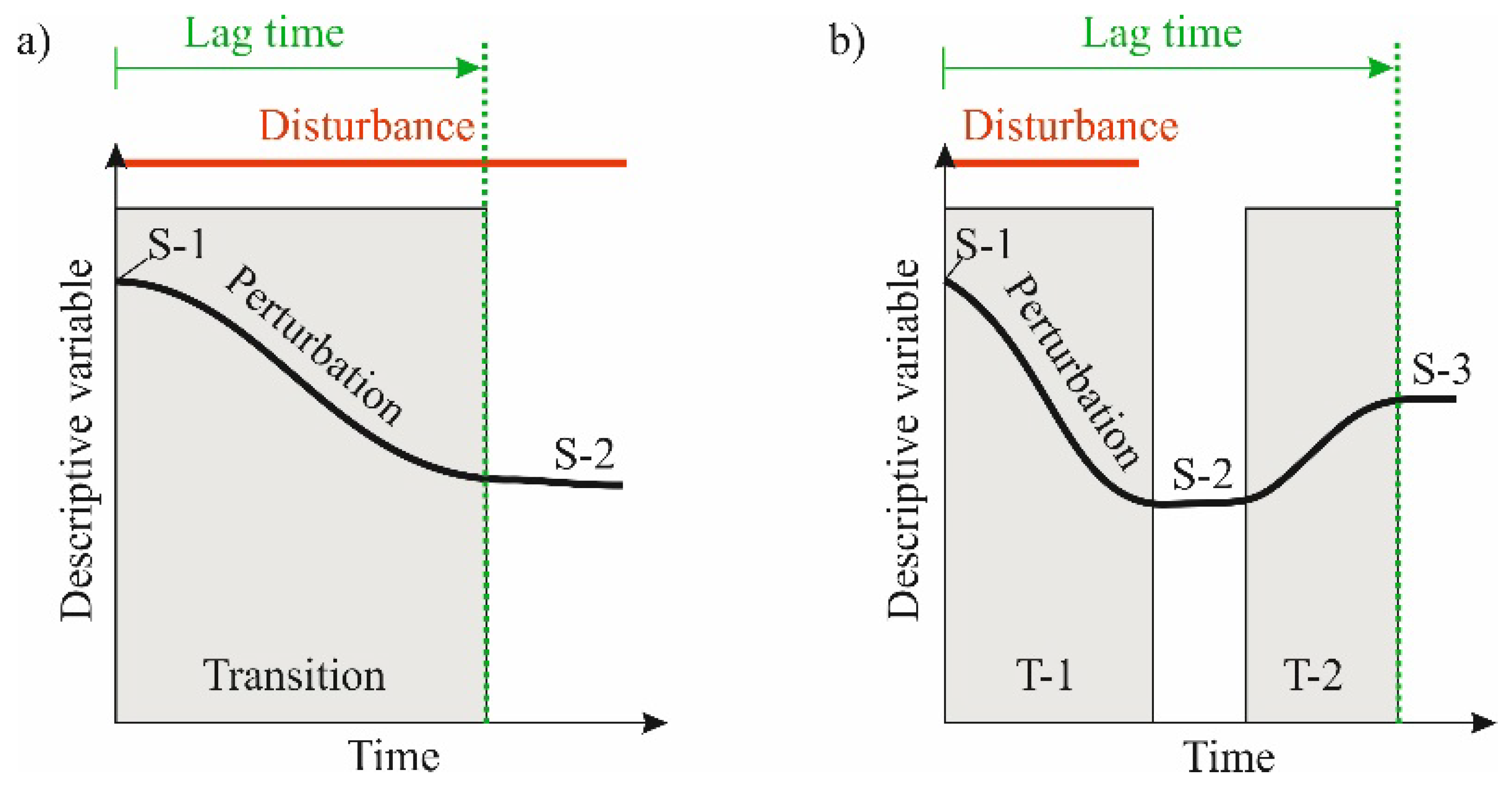
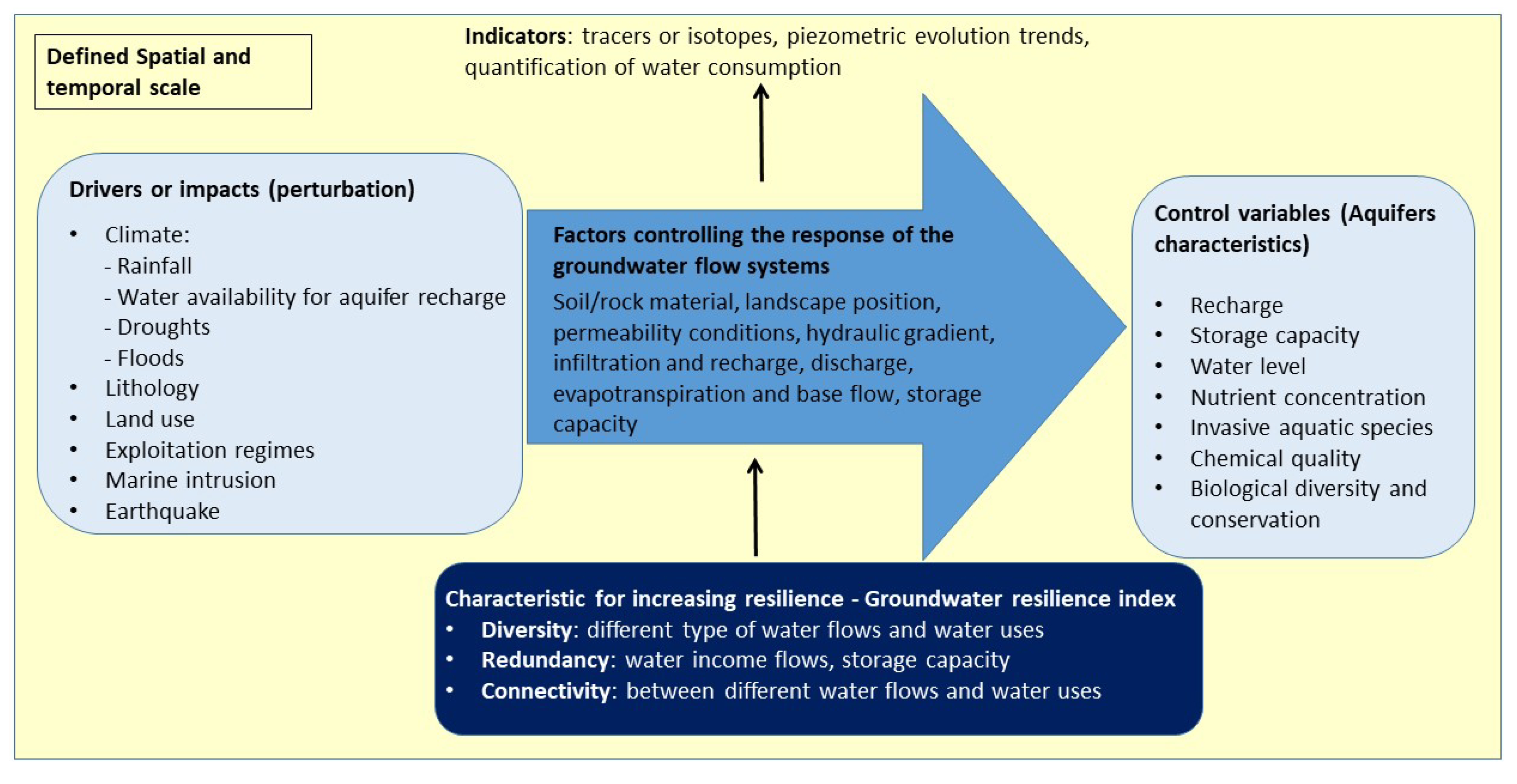
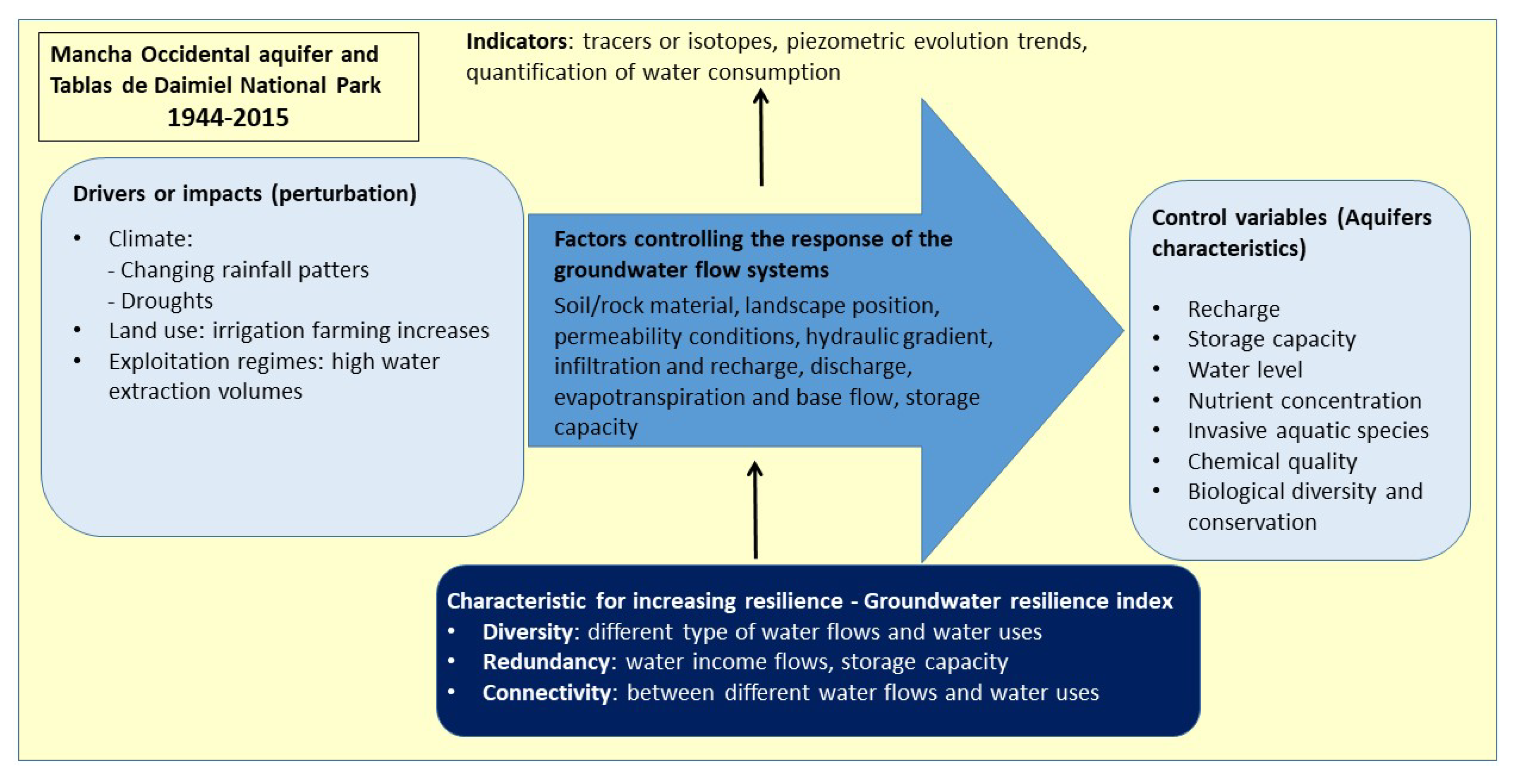
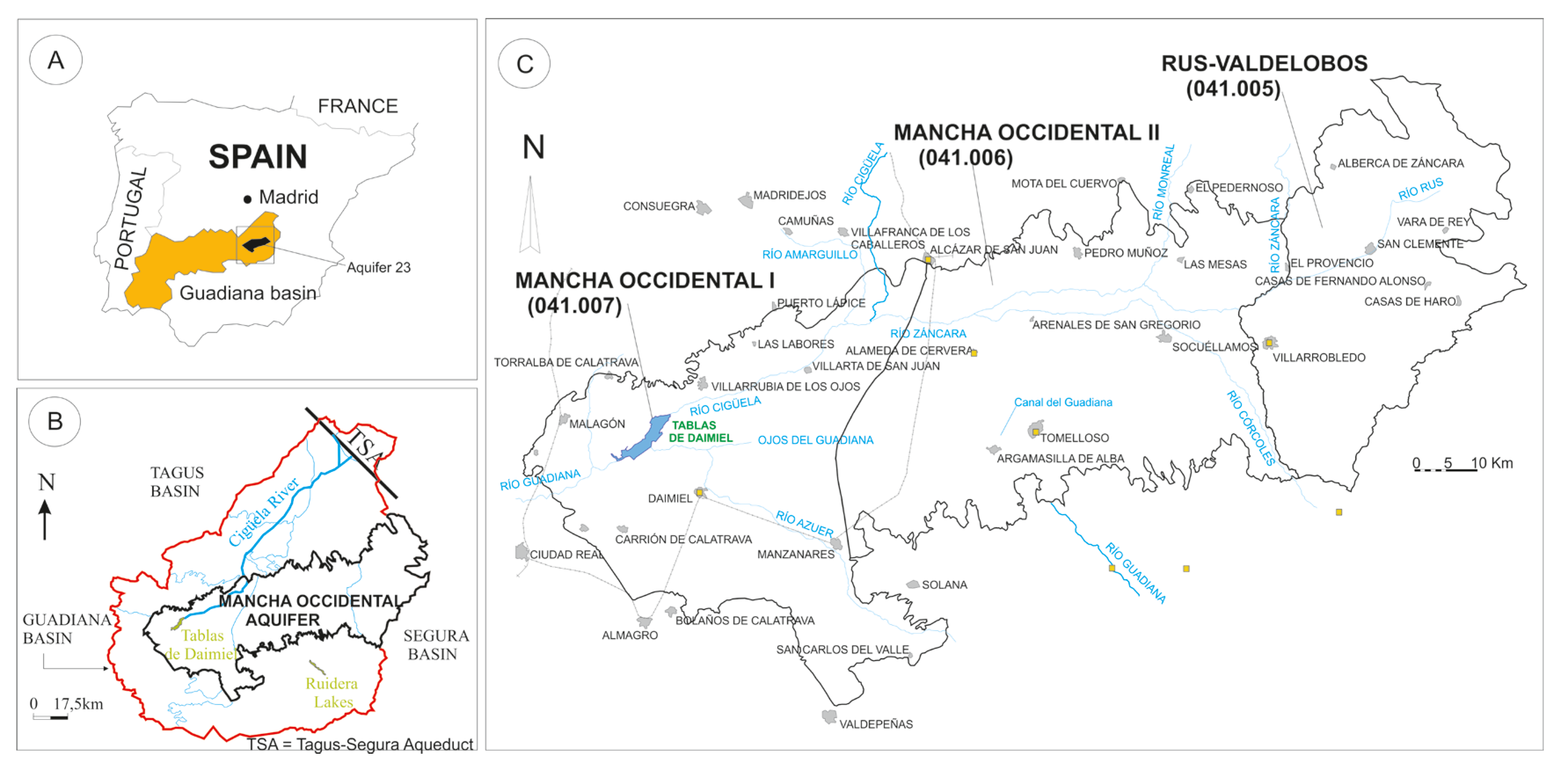
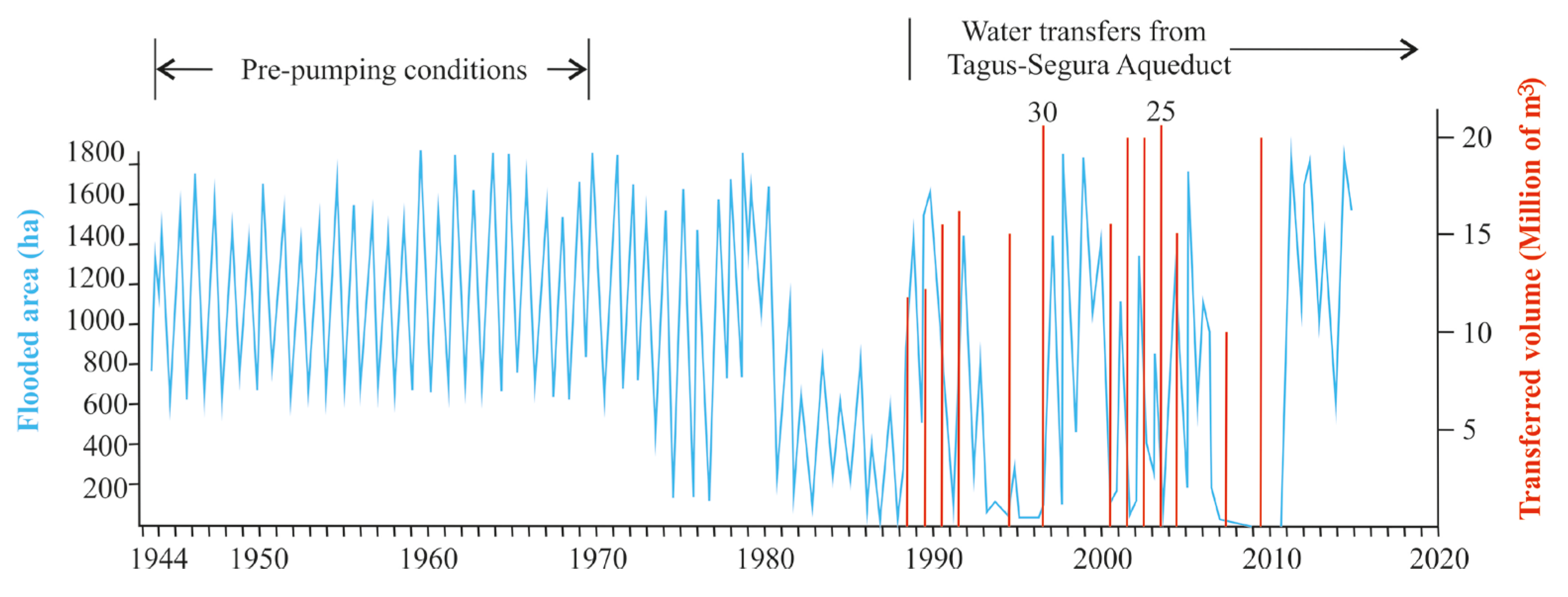

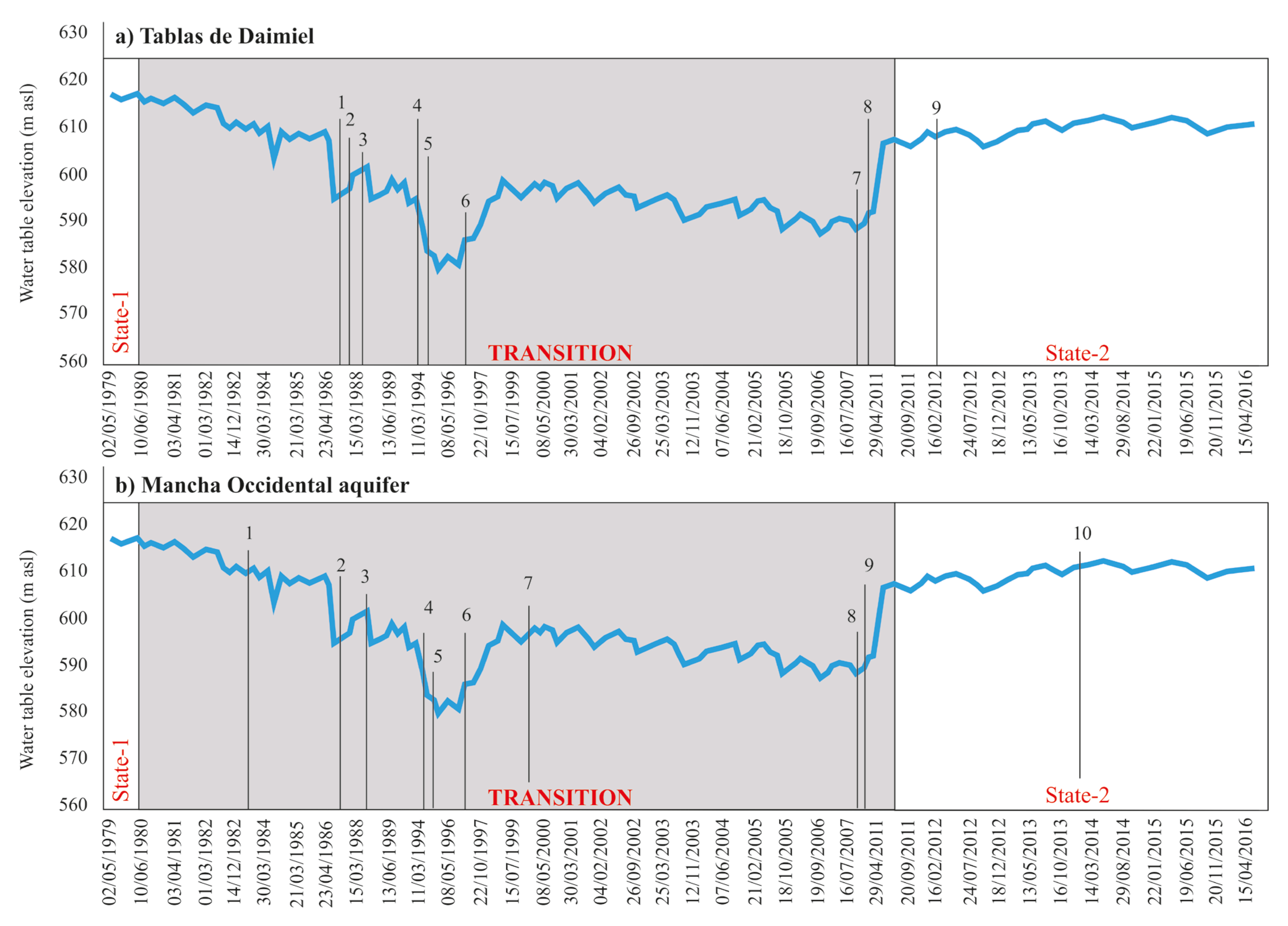
| Word | Definition | Source |
|---|---|---|
| Adaptive capacity | Latent potential of an ecosystem to alter resilience in response to change. Similarly, in the ecological sciences, adaptation, adaptedness, adaptability and adaptive capacity, terms with different meanings, have often been used interchangeably. | [57] |
| Alternative state/regime | A potential alternative configuration of a system in terms of the structural and functional composition, processes, and feedbacks. | [57] |
| Critical slowing down (CSD) | CSD occurs as the system approaches the threshold, the distance to the critical threshold is reduced, the recovery rate decreases and ecological resilience declines. | [37] |
| Early-warning signal (EWS) | A statistical signal indicative of a system approaching a critical transition. (Often used interchangeably with leading indicator. Examples are variance or autocorrelation.) | [56] (p.906) |
| Forcing | External pressures that destabilize a system, pushing it towards a tipping point. | [56] (p.906) |
| Hydrogeological systems | Set of geological formations whose hydrogeological functioning should be considered together. | |
| Linear system | System whose behavior is expressible by adding the behaviors of its descriptors. | |
| Perturbance/disturbances | Alteration in the order or the permanent characteristics that comprise the normal development of a process. | |
| Pressure | Activities subject to generate impacts on groundwater | [58] |
| Regime shift (“change” in other references) | Persistent change in structure, function, and feedback of an ecosystem. (This term is used interchangeably with “critical transition” in the literature.) We will use “state” instead of “regime” in this paper. | [57] |
| Scale | The geographic extension over which a process operates and the frequency with which a process occurs. | [1,51] |
| Stability | A system characteristic whereby system properties remain unchanged following disturbance. Adaptive capacity can increase stability, but system components can fluctuate (and are therefore unstable) while still remaining within the range of values that signify a particular state. | [57] |
| Stressor | Stimuli or situations capable of producing certain changes that trigger the stress response. | |
| Transient regime | Response of a system that changes over time, as opposed to the permanent regime. | |
| Tipping point (threshold, bifurcation point) | The point at which a system is so unstable that even small perturbations cause dramatic shifts in its state. | [59] |
| Variables describing change (fast variables, controlling variables and control variables) | Fast and slow variables. “Fast” variables are those that are of primary concern to system users. The dynamic of these fast variables is strongly shaped by other system variables that generally change much more slowly. “Slow” variables or controlling variables are not the same as control variables. | [45] |
© 2020 by the authors. Licensee MDPI, Basel, Switzerland. This article is an open access article distributed under the terms and conditions of the Creative Commons Attribution (CC BY) license (http://creativecommons.org/licenses/by/4.0/).
Share and Cite
de la Hera-Portillo, Á.; López-Gutiérrez, J.; Zorrilla-Miras, P.; Mayor, B.; López-Gunn, E. The Ecosystem Resilience Concept Applied to Hydrogeological Systems: A General Approach. Water 2020, 12, 1824. https://doi.org/10.3390/w12061824
de la Hera-Portillo Á, López-Gutiérrez J, Zorrilla-Miras P, Mayor B, López-Gunn E. The Ecosystem Resilience Concept Applied to Hydrogeological Systems: A General Approach. Water. 2020; 12(6):1824. https://doi.org/10.3390/w12061824
Chicago/Turabian Stylede la Hera-Portillo, África, Julio López-Gutiérrez, Pedro Zorrilla-Miras, Beatriz Mayor, and Elena López-Gunn. 2020. "The Ecosystem Resilience Concept Applied to Hydrogeological Systems: A General Approach" Water 12, no. 6: 1824. https://doi.org/10.3390/w12061824
APA Stylede la Hera-Portillo, Á., López-Gutiérrez, J., Zorrilla-Miras, P., Mayor, B., & López-Gunn, E. (2020). The Ecosystem Resilience Concept Applied to Hydrogeological Systems: A General Approach. Water, 12(6), 1824. https://doi.org/10.3390/w12061824




